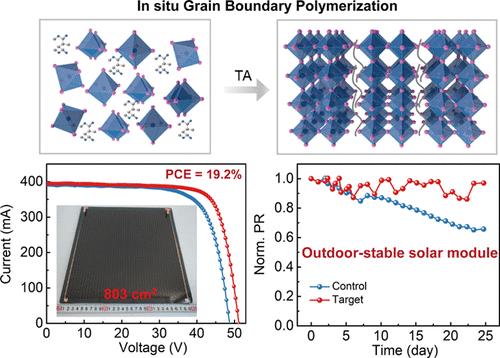减少晶间间隙以稳定钙钛矿太阳能组件的室外运行
IF 18.2
1区 材料科学
Q1 CHEMISTRY, PHYSICAL
引用次数: 0
摘要
环境应力导致的晶界空洞和界面分层是影响钙钛矿太阳能电池长期室外运行稳定性的关键问题。在这里,我们开发了一种使用衣康酸二甲基(DMI)单体的晶界聚合策略来减少钙钛矿薄膜的晶粒间隙。晶粒间隙的减小有效地缓解了器件内部的大块空隙和界面分层现象,抑制了钙钛矿层外离子的迁移。因此,我们在0.09平方厘米的实验室规模电池中实现了25.9%的功率转换效率(25.24%的认证),在30厘米× 30厘米的工业规模太阳能组件中实现了19.2%的功率转换效率。封装模块在湿热条件和最大功率点跟踪下分别保持了2000和3000小时初始效率的93%和94%,代表了迄今为止报道的最稳定的工业规模太阳能模块之一。重要的是,这些封装模块在户外运行25天内表现出稳定的功率输出,证明了它们在实际应用中的可行性。本文章由计算机程序翻译,如有差异,请以英文原文为准。

Reducing Inter-grain Gaps to Stabilize the Outdoor Operation of Perovskite Solar Modules
The grain boundary voids and interfacial delamination driven by environmental stress constitute a critical issue that affects the long-term outdoor operational stability of perovskite solar cells. Here, we developed a grain boundary polymerization strategy using dimethyl itaconate (DMI) monomers to reduce the inter-grain gaps of perovskite film. The reduced inter-grain gaps effectively alleviate the bulk voids and interfacial delamination in the devices and inhibit mobile ion migration out of the perovskite layer. Consequently, we achieved power conversion efficiencies of 25.9% (25.24% certified) in 0.09 cm2 lab-scale cells and 19.2% in 30 cm × 30 cm industrial-scale solar modules. The encapsulated modules retained 93% and 94% of their initial efficiencies for 2000 and 3000 h in damp-heat conditions and at maximum power point tracking, respectively, representing one of the most stable industrial-scale solar modules reported to date. Importantly, these encapsulated modules exhibited steady power output over 25 days of outdoor operation, demonstrating their viability for practical real-world applications.
求助全文
通过发布文献求助,成功后即可免费获取论文全文。
去求助
来源期刊

ACS Energy Letters
Energy-Renewable Energy, Sustainability and the Environment
CiteScore
31.20
自引率
5.00%
发文量
469
审稿时长
1 months
期刊介绍:
ACS Energy Letters is a monthly journal that publishes papers reporting new scientific advances in energy research. The journal focuses on topics that are of interest to scientists working in the fundamental and applied sciences. Rapid publication is a central criterion for acceptance, and the journal is known for its quick publication times, with an average of 4-6 weeks from submission to web publication in As Soon As Publishable format.
ACS Energy Letters is ranked as the number one journal in the Web of Science Electrochemistry category. It also ranks within the top 10 journals for Physical Chemistry, Energy & Fuels, and Nanoscience & Nanotechnology.
The journal offers several types of articles, including Letters, Energy Express, Perspectives, Reviews, Editorials, Viewpoints and Energy Focus. Additionally, authors have the option to submit videos that summarize or support the information presented in a Perspective or Review article, which can be highlighted on the journal's website. ACS Energy Letters is abstracted and indexed in Chemical Abstracts Service/SciFinder, EBSCO-summon, PubMed, Web of Science, Scopus and Portico.
 求助内容:
求助内容: 应助结果提醒方式:
应助结果提醒方式:


